Climate Change Impacts on Sugarcane Production in Thailand
Abstract
1. Introduction
2. Materials and Methods
2.1. Model Estimation Approach
2.2. Data
3. Results and Discussion
3.1. Estimated Results
3.1.1. Determinants of Sugarcane Yields
3.1.2. Determinants of Harvested Area
3.1.3. Improvement in Estimation
3.2. Simulation of Climate Change Impacts on Production of Sugarcane
4. Conclusions
Author Contributions
Funding
Conflicts of Interest
Appendix A
| Average Temperature | Total Rain | Maximum Rain in 24 h | Extreme Max. Temperature | |||||
|---|---|---|---|---|---|---|---|---|
| Latitude | 14.5154 | *** | 737.2921 | * | −449.4323 | *** | −80.9482 | *** |
| (2.1368) | (433.2796) | (127.9690) | (24.2753) | |||||
| Latitude_sq | 0.0442 | ** | 9.0523 | ** | 8.9787 | *** | 0.2565 | |
| (0.0174) | (3.5243) | (1.0409) | (0.1577) | |||||
| Longitude | 19.5990 | *** | −9188.7530 | *** | −296.0857 | −204.6332 | *** | |
| (6.4092) | (1299.5850) | (383.8320) | (39.7748) | |||||
| Longitude_sq | −0.0860 | *** | 46.8822 | *** | 1.4239 | 0.9611 | *** | |
| (0.0316) | (6.4126) | (1.8939) | (0.1910) | |||||
| Latitude* Longitude | −0.1616 | *** | −9.2311 | ** | 1.9145 | * | 0.7447 | *** |
| (0.0184) | (3.7253) | (1.1003) | (0.2413) | |||||
| Height | −0.3509 | *** | 61.0837 | *** | 16.6274 | *** | −0.6956 | |
| (0.0385) | (7.7988) | (2.3034) | (0.4141) | |||||
| Height_sq | 0.0000 | 0.0021 | *** | 0.0002 | * | 0.0000 | * | |
| (0.0000) | (0.0006) | (0.0002) | (0.0000) | |||||
| Height_*Latitude | 0.0030 | *** | −0.7504 | *** | −0.2224 | *** | –0.0109 | ** |
| (0.0003) | (0.0695) | (0.0205) | (0.0051) | |||||
| Height* Longitude | 0.0030 | *** | −0.5090 | *** | −0.1332 | *** | 0.0082 | * |
| (0.0003) | (0.0672) | (0.0198) | (0.0043) | |||||
| Constant | −1056.2490 | *** | 451,024.7000 | *** | 17,267.2400 | 10,929.9900 | *** | |
| (325.1456) | (65,928.9500) | (19,472.1000) | (2084.0220) | |||||
| R-squared | 0.9140 | 0.5537 | 0.5219 | 0.6409 | ||||
| Predicted value | 28.29712 | *** | 205.7859 | *** | 53.06985 | *** | 35.87393 | *** |
| 0.0141769 | 2.874609 | 0.8490152 | 0.131078 |
| 1. Existing Model (IV and Spatial Regression with Price and Wage Variables) | 2. IV and Spatial Regression without Price and Wage Variables | 3. OLS without Price and Wage Variables | |
|---|---|---|---|
| Variables | Coefficients | Coefficients | Coefficients |
| Time trend | −1684.42 *** | 197.8 | 61.32 |
| Time trend_sq | 127.56 *** | 26.60 *** | 35.07 *** |
| %Irrigated area per province area | 100.52 *** | 110.9 *** | 115.8 *** |
| Average temperature | 165,114.40 *** | 112,887 *** | 81,758 *** |
| Average temperature_sq | −2942.43 *** | −2024 *** | −1422 *** |
| Total rain | −37.08 *** | −8.485 | −6.193 |
| Total rain_sq | 0.01 ** | 0.00195 | 0.0016 |
| Maximum rain in 24 h | 274.62 ** | −198.2 | −366.5 *** |
| Extreme max. temperature | −8592.73 *** | −9363 *** | −11,825 *** |
| El Niño | −513.00 | 190.1 | 247.6 |
| La Niña | −2244.31 *** | 389.2 | 715.1 ** |
| North | 4057.12 *** | 4386 *** | 6610 *** |
| Northeast | 5618.21 *** | 6250 *** | 8975 *** |
| Southeast | −12,246.34 *** | −10,585 *** | −13,390 *** |
| East | −3348.69 *** | −2834 ** | −3860 |
| Lag price | −645.31 *** | - | - |
| Lag wage | −8765.63 *** | - | - |
| Constant | −1.87 × 106 *** | −1.18 × 106 *** | −687,863 *** |
| Observations | 1242 | 1242 | 1242 |
| R-square_adj. | 0.49 | 0.40 | 0.427 |
| Root MSE | 6747.97 | 7534.01 | 7562.85 |
| Harvested Area | 1. Existing Model (IV and Spatial Regression with Price and Wage Variables) | 2. IV and Spatial Regression without Price and Wage Variables | 3. OLS without Price and Wage Variables |
|---|---|---|---|
| Variables | Coefficients | Coefficients | Coefficients |
| Time Trend | 1.04 ** | −0.528 | 0.249 |
| Time Trend_sq | −0.05 ** | 0.0411 *** | 0.0134 * |
| Population density | −0.07 *** | −0.0396 ** | −0.278 *** |
| %Irrigated area per province area | −0.09 ** | −0.144 *** | −0.038 |
| Total rain | 0.05 * | 0.0172 | −0.0347 ** |
| Total rain_sq | −2.20 × 10−5 ** | −1.30 × 10−5 | 1.06 × 10−5 ** |
| Maximum rain in 24 h | −0.44 | 0.338 | 0.204 |
| Extreme max. temperature | −0.43 | 2.907 * | 0.798 |
| El Niño | −0.67 | −0.551 | 1.407 *** |
| La Niña | 7.65 *** | 3.354 ** | 0.0332 |
| North | −16.46 *** | −17.38 *** | −40.50 *** |
| Northeast | −8.37 ** | −11.59 *** | −26.06 * |
| Southeast | −10.82 | −7.51 | −51.39 *** |
| East | −19.34 *** | −18.42 *** | −35.15 ** |
| Lag price | 0.23 | - | - |
| Lag wage | 10.78 *** | - | - |
| Constant | −36.04 | −75.65 | 68.21 ** |
| Observations | 1242 | 1242 | 1242 |
| R-square_adj. | 0.11 | 0.09 | 0.0965 |
| Root MSE | 10.90 | 10.92 | 10.310 |
References
- FAO. Is sugar pure, white and deadly? In Proceedings of the Fiji/FAO Asia Pacific Sugar Conference, Suva, Fiji, 29–31 October 1997; pp. 41–44. [Google Scholar]
- International Sugar Organization. The Sugar Market. 2019. Available online: https://www.isosugar.org/sugarsector/sugar (accessed on 23 August 2019).
- Murphy, R. Sugarcane: Production Systems, Uses and Economic Importance; Nova Science: New York, NY, USA, 2017; p. 39. [Google Scholar]
- FAOSTAT. Food and Agriculture Organization of the United Nations, Statistics Division. Forestry Production and Trade. Available online: http://www.fao.org/faostat/en/#data/FO (accessed on 4 April 2019).
- USDA. Foreign Agricultural Service. Production, Supply and Distribution. 2020. Available online: https://apps.fas.usda.gov/psdonline/app/index.html#/app/advQuery (accessed on 28 February 2020).
- UN Comtrade. World Cane Sugar Export’s Statistics. 2019. Available online: https://comtrade.un.org/data/https://comtrade.un.org/data (accessed on 25 August 2019).
- Office of the Cane and Sugar Board. Production Report. 2019. Available online: http://www.ocsb.go.th/th/home/index.php (accessed on 20 February 2020).
- Bangkok Post. Thai Sugar Body Seeks to Sweeten Environment and Health. 2019. Available online: https://www.bangkokpost.com/business/1758849/thai-sugar-body-seeks-to-sweeten-environment-and (accessed on 22 February 2020).
- IPCC. 2013: Annex I: Atlas of Global and Regional Climate Projections. In Climate Change 2013: The Physical Science Basis. Contribution of Working Group I to the Fifth Assessment Report of the Intergovermental Panel on Climate Change; Cambridge University Press: Cambridge, UK; New York, NY, USA, 2013; pp. 1311–1393. [Google Scholar]
- Adams, R.M.; Rosenzweig, C.; Peart, R.M.; Ritchie, J.T.; McCarl, B.A.; Glyer, J.D.; Curry, R.B.; Jones, J.W.; Boote, K.; Allen, L.H. Global climate change and US agriculture. Nature 1990, 345, 219–224. [Google Scholar] [CrossRef]
- Attavanich, W.; McCarl, B.A. How is CO2 affecting yields and technological progress? A statistical analysis. Clim. Chang. 2014, 124, 747–762. [Google Scholar] [CrossRef]
- Mendelsohn, R.; Nordhaus, W.D.; Shaw, D. The impact of global warming on agriculture: A Ricardian analysis. Am. Econ. Rev. 1994, 84, 753–771. [Google Scholar]
- Parry, M.L.; Rosenzweig, C.; Iglesias, A.; Livermore, M.; Fischer, G. Effects of climate change on global food production under SRES emissions and socio-economic scenarios. Glob. Environ. Chang. 2004, 14, 53–67. [Google Scholar] [CrossRef]
- Miao, R.; Khanna, M.; Huang, H. Responsiveness of Crop Yield and Acreage to Prices and Climate. Am. J. Agric. Econ. 2015, 98, 191–211. [Google Scholar] [CrossRef]
- Schlenker, W.; Roberts, M.J. Nonlinear temperature effects indicate severe damages to U.S. crop yields under climate change. Proc. Natl. Acad. Sci. USA 2009, 106, 15594–15598. [Google Scholar] [CrossRef]
- Rosenzweig, C.; Iglesias, A.; Yang, X.; Epstein, P.R.; Chivian, E. Climate Change and Extreme Weather Events; Implications for Food Production, Plant Diseases, and Pests. Glob. Chang. Hum. Health 2001, 2, 90–104. [Google Scholar] [CrossRef]
- Cammarano, D.; Ceccarelli, S.; Grando, S.; Romagosa, I.; Benbelkacem, A.; Akar, T.; Al-Yassin, A.; Pecchioni, N.; Francia, E.; Ronga, D. The impact of climate change on barley yield in the Mediterranean basin. Eur. J. Agron. 2019, 106, 1–11. [Google Scholar] [CrossRef]
- Lobell, D.B.; Schlenker, W.; Costa-Roberts, J. Climate Trends and Global Crop Production since 1980. Science 2011, 333, 616–620. [Google Scholar] [CrossRef]
- Raymundo, R.; Asseng, S.; Robertson, R.; Petsakos, A.; Hoogenboom, G.; Quiroz, R.; Hareau, G.; Wolf, J. Climate change impact on global potato production. Eur. J. Agron. 2018, 100, 87–98. [Google Scholar] [CrossRef]
- Zhao, C.; Liu, B.; Piao, S.; Wang, X.; Lobell, D.B.; Huang, Y.; Huang, M.; Yao, Y.; Bassu, S.; Ciais, P.; et al. Temperature increase reduces global yields of major crops in four independent estimates. Proc. Natl. Acad. Sci. USA 2017, 114, 9326–9331. [Google Scholar] [CrossRef] [PubMed]
- Attavanich, W.; McCarl, B.A.; Ahmedov, Z.; Fuller, S.W.; Vedenov, D.V. Effects of climate change on US grain transport. Nat. Clim. Chang. 2013, 3, 638–643. [Google Scholar] [CrossRef]
- Brown, M.E.; Antle, J.; Backlund, P.; Carr, E.; Easterling, W.; Walsh, M.; Ammann, C.; Attavanich, W.; Barrett, C.; Bellemare, M.; et al. Climate Change, Global Food Security, and the U.S. Food System. Available online: http://www.usda.gov/oce/climate_change/FoodSecurity2015Assessment/FullAssessment.pdf (accessed on 10 May 2019).
- Brown, M.E.; Carr, E.R.; Grace, K.L.; Wiebe, K.; Funk, C.C.; Attavanich, W.; Backlund, P.; Buja, L. Do markets and trade help or hurt the global food system adapt to climate change? Food Policy 2017, 68, 154–159. [Google Scholar] [CrossRef]
- Singels, A.; Jones, M.; Marin, F.; Ruane, A.; Thorburn, P. Predicting Climate Change Impacts on Sugarcane Production at Sites in Australia, Brazil and South Africa Using the Canegro Model. Sugar Tech. 2013, 16, 347–355. [Google Scholar] [CrossRef]
- Marin, F.R.; Jones, J.W.; Singels, A.; Royce, F.; Assad, E.; Pellegrino, G.Q.; Justino, F. Climate change impacts on sugarcane attainable yield in southern Brazil. Clim. Chang. 2012, 117, 227–239. [Google Scholar] [CrossRef]
- Silva, W.K.D.M.; De Freitas, G.P.; Junior, L.M.C.; Pinto, P.A.L.D.A.; Abrahão, R. Effects of climate change on sugarcane production in the state of Paraíba (Brazil): A panel data approach (1990–2015). Clim. Chang. 2019, 154, 195–209. [Google Scholar] [CrossRef]
- Baez-Gonzalez, A.D.; Kiniry, J.; Meki, M.N.; Williams, J.R.; Cilva, M.A.; Gonzalez, J.L.R.; Estala, A.M. Potential impact of future climate change on sugarcane under dryland conditions in Mexico. J. Agron. Crop. Sci. 2018, 204, 515–528. [Google Scholar] [CrossRef]
- Ruan, H.; Feng, P.; Wang, B.; Xing, H.; O’Leary, G.J.; Huang, Z.; Guo, H.; Liu, D.L. Future climate change projects positive impacts on sugarcane productivity in southern China. Eur. J. Agron. 2018, 96, 108–119. [Google Scholar] [CrossRef]
- Adhikari, U.; Nejadhashemi, A.P.; Woznicki, S.A. Climate change and eastern Africa: A review of impact on major crops. Food Energy Secur. 2015, 4, 110–132. [Google Scholar] [CrossRef]
- Lobell, D.B.; Burke, M.; Tebaldi, C.; Mastrandrea, M.D.; Falcon, W.P.; Naylor, R.L. Prioritizing Climate Change Adaptation Needs for Food Security in 2030. Science 2008, 319, 607–610. [Google Scholar] [CrossRef]
- Yoshida, K.; Srisutham, M.; Sritumboon, S.; Suanburi, D.; Janjirauttikul, N. Weather-induced economic damage to upland crops and the impact on farmer household income in Northeast Thailand. Paddy Water Environ. 2019, 17, 341–349. [Google Scholar] [CrossRef]
- Feng, H.; Babcock, B.A. Impacts of Ethanol on Planted Acreage in Market Equilibrium. Am. J. Agric. Econ. 2010, 92, 789–802. [Google Scholar] [CrossRef]
- FAO. The Future of Food and Agriculture–Trends and Challenges; Food and Agriculture Organization of the United Nations: Rome, Italy, 2017. [Google Scholar]
- Reuters. Thailand’s Sugar Output to Hit Nine-Year Low Due to Drought—Trade Body. 2020. Available online: https://www.reuters.com/article/thailand-sugar-output/thailands-sugar-output-to-hit-nine-year-low-due-to-drought-trade-body-idINKBN1ZU1Z3 (accessed on 13 April 2020).
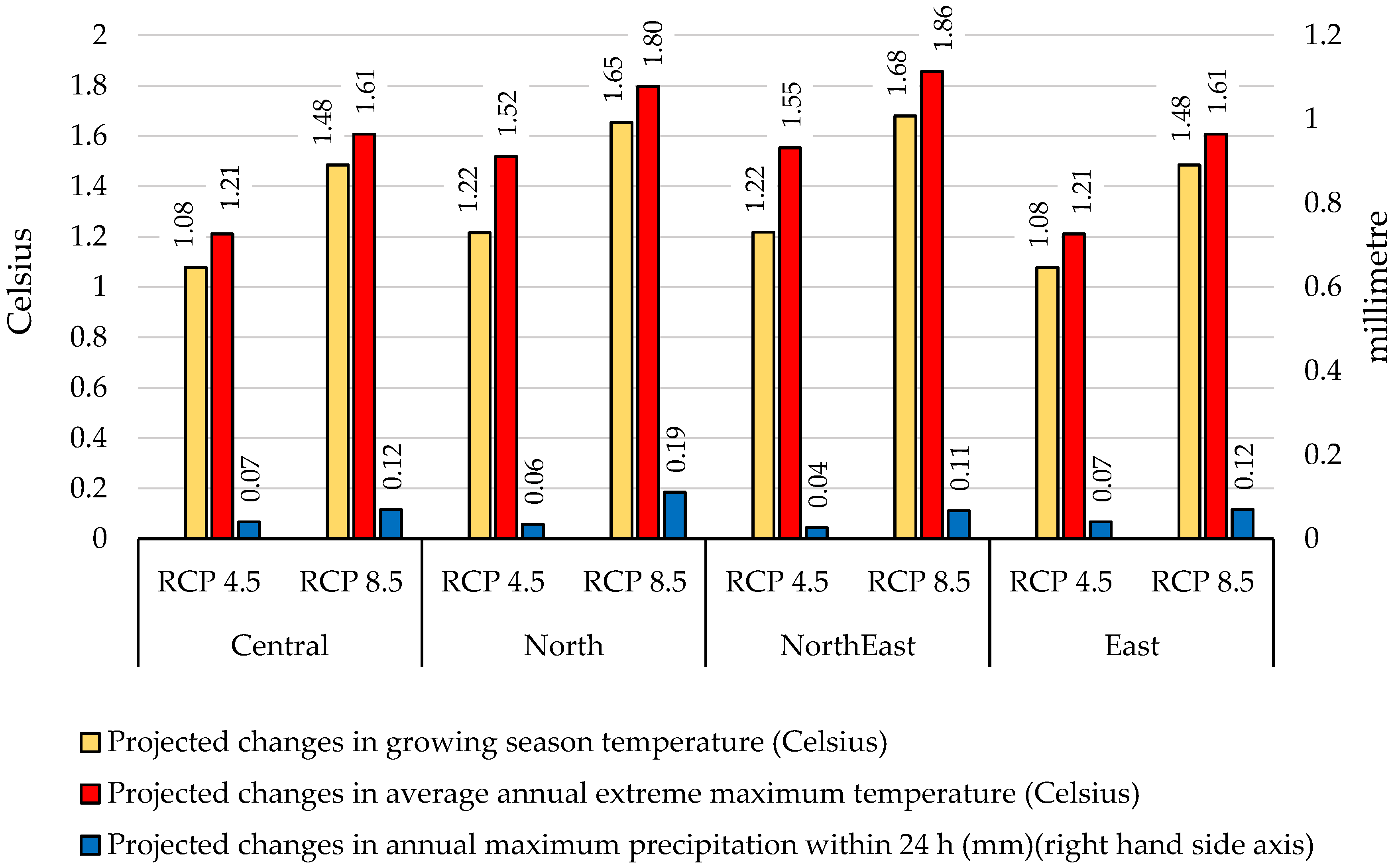
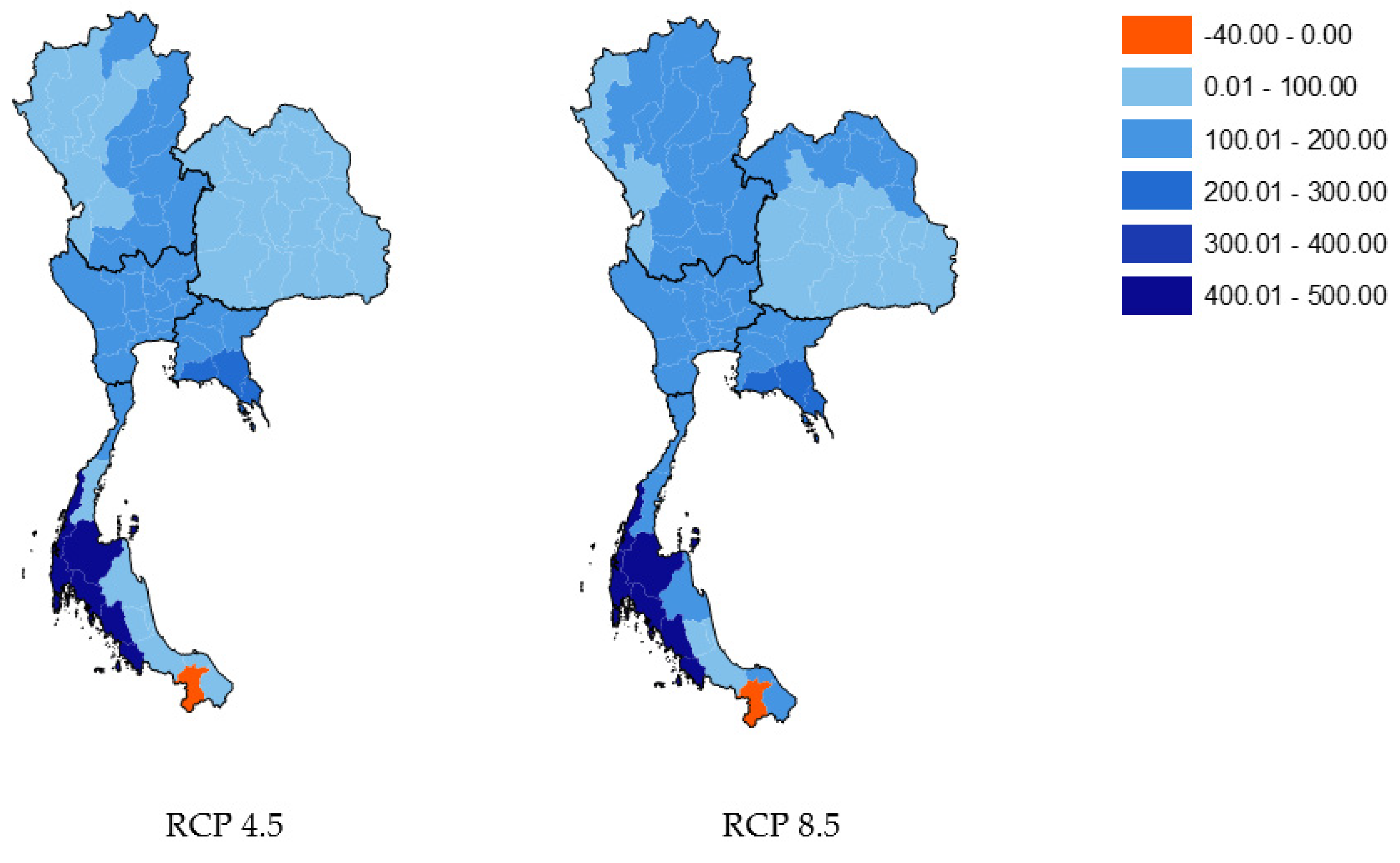
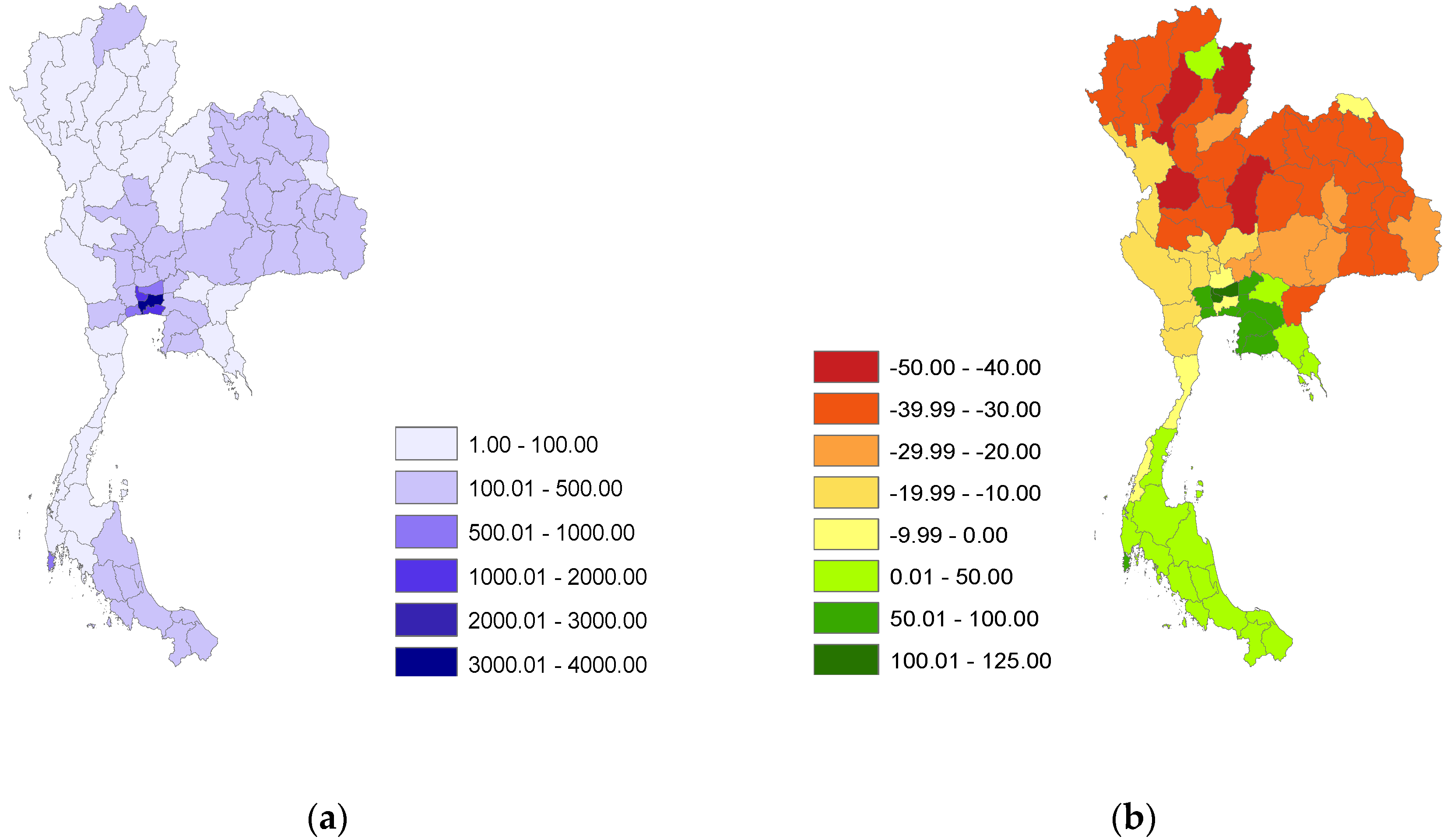
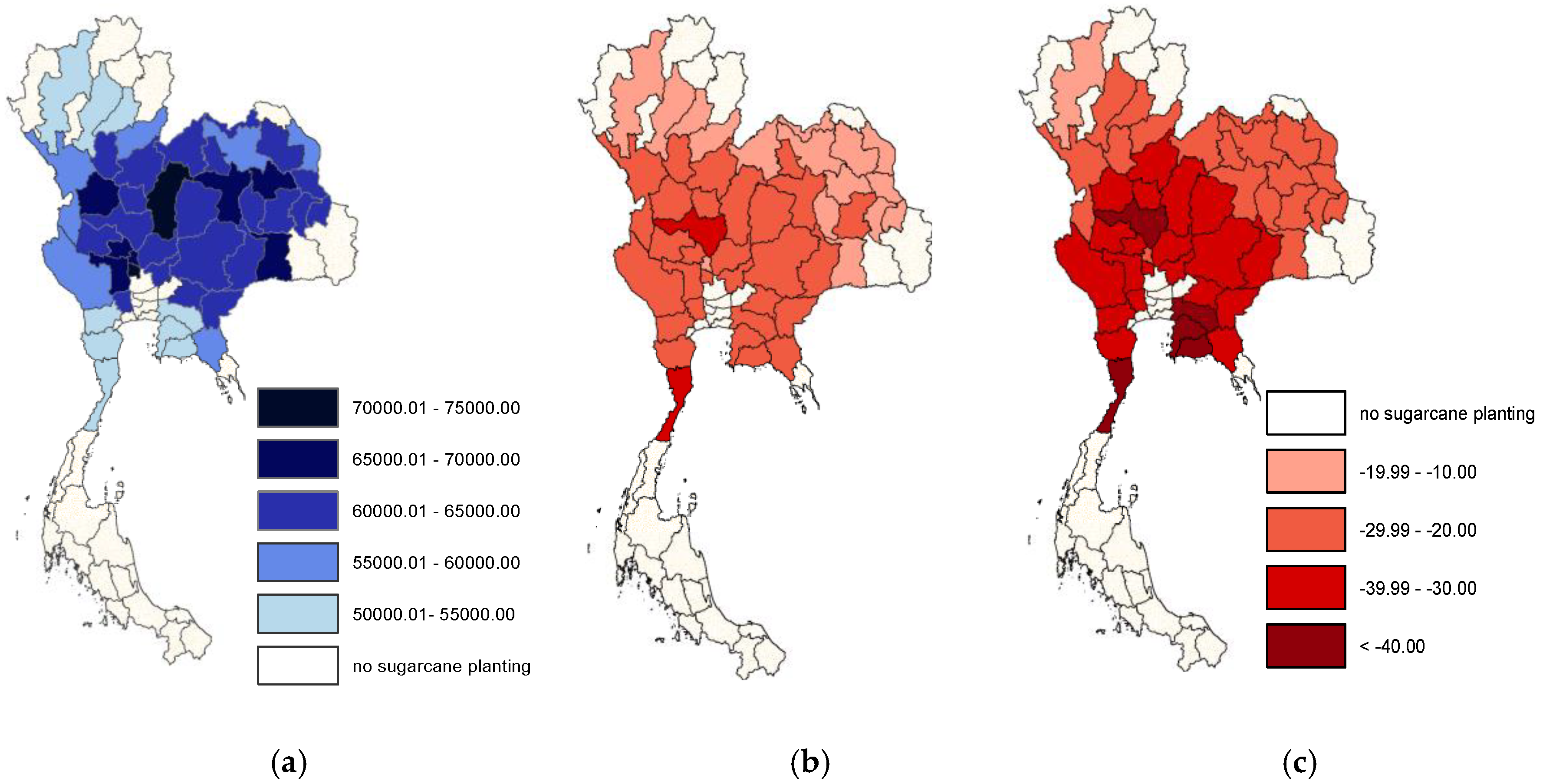
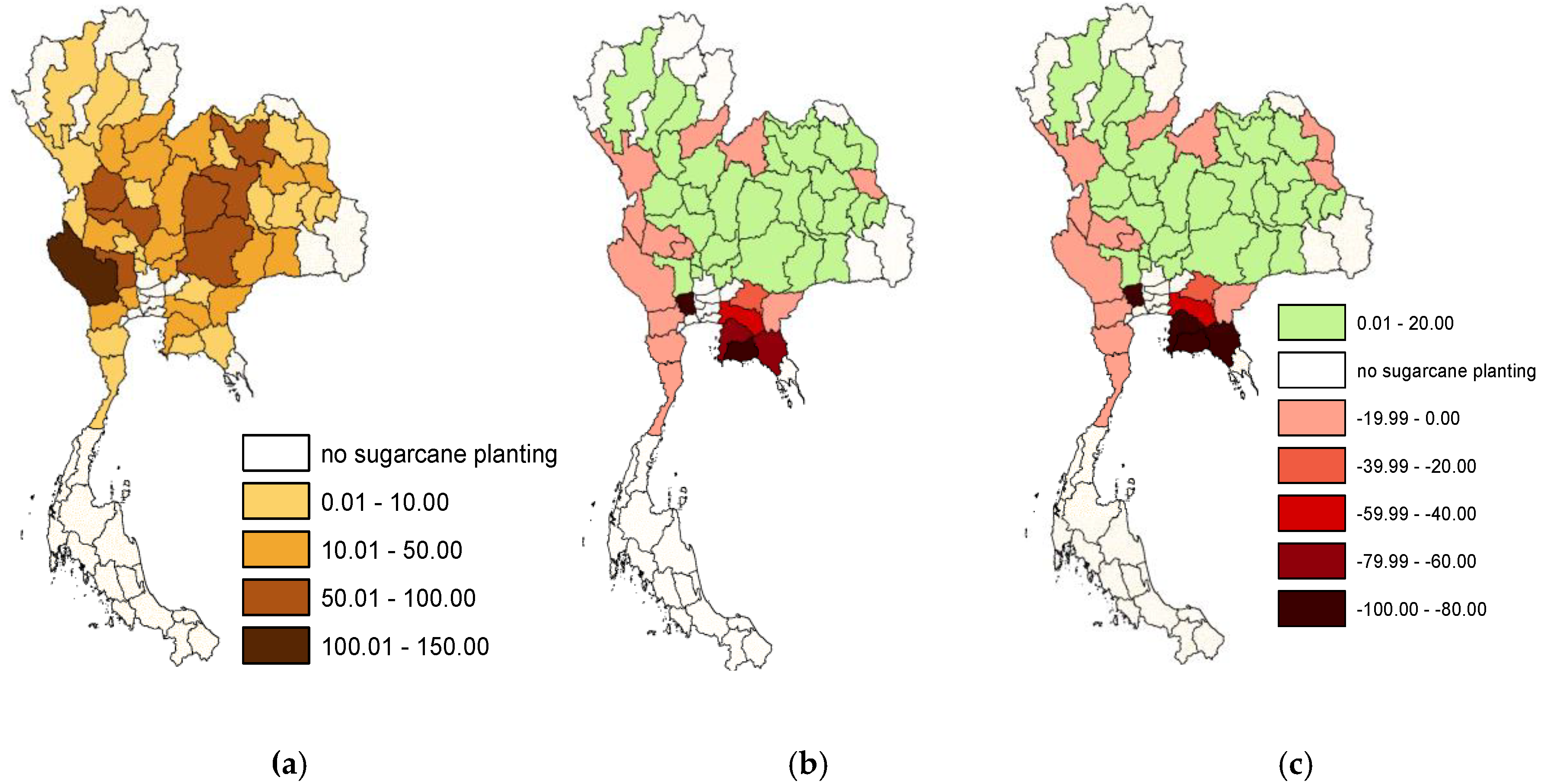
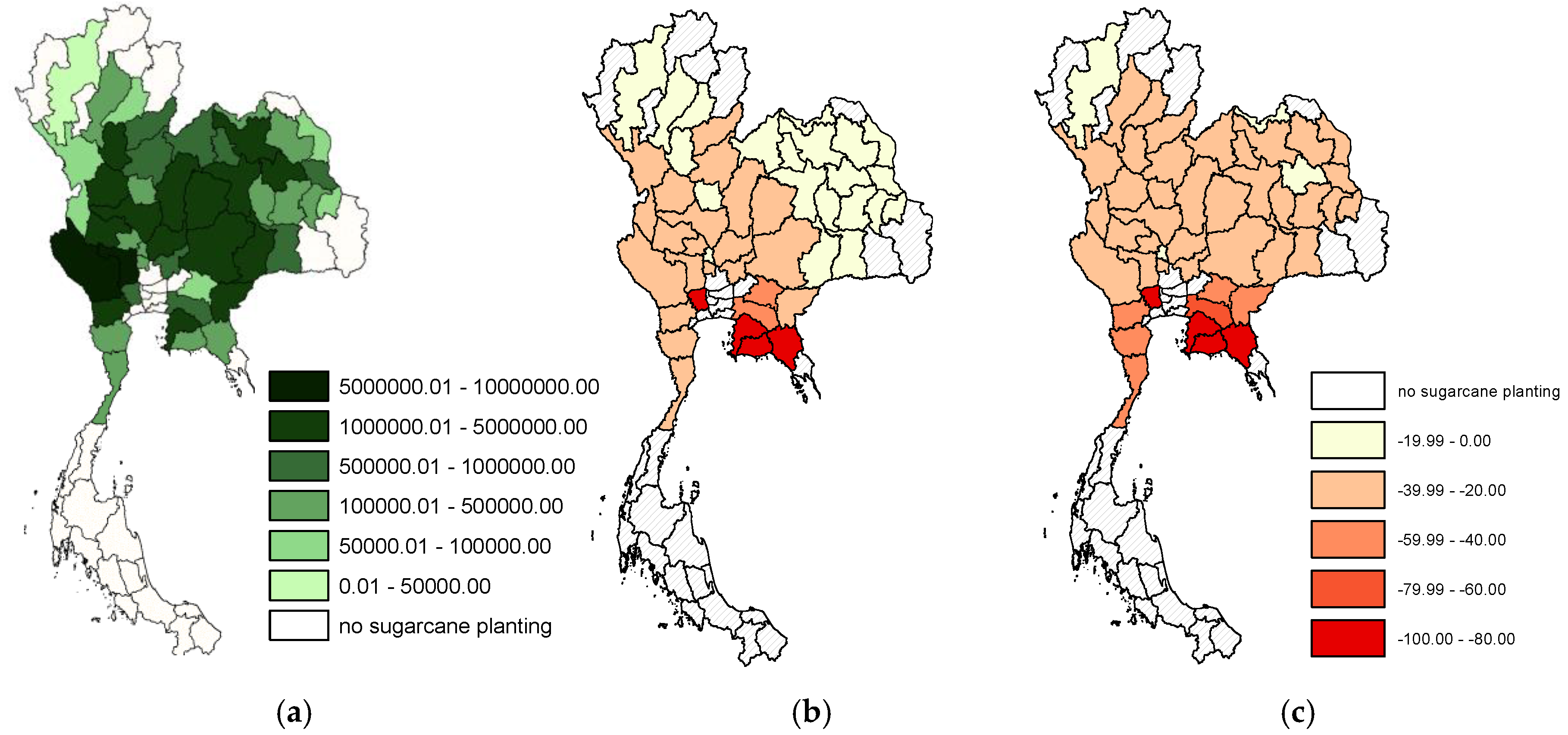
| Variables | Mean | SD | Min | Max |
|---|---|---|---|---|
| Yield (kg/ha) | 58,652.50 | 11,093.84 | 18,612.50 | 92,462.50 |
| Harvested area (1000 ha) | 22.89 | 29.09 | 0.03 | 161.41 |
| Average temperature (°C) | 27.59 | 0.67 | 25.57 | 29.10 |
| Maximum rainfall in 24 h (mm/day) | 33.69 | 3.93 | 22.98 | 47.28 |
| Extreme maximum temperature (°C) | 35.91 | 0.55 | 34.49 | 37.38 |
| Total rainfall (mm) | 1331.35 | 204.97 | 886.76 | 2007.98 |
| Population density (person/km2) | 125.64 | 67.17 | 21.56 | 417.38 |
| Lag received price (USD/ton) | 25.01 | 4.54 | 13.27 | 42.90 |
| Lag wage (USD) | 6.47 | 1.26 | 4.88 | 9.91 |
| %Irrigated area per province area | 12.72 | 25.81 | 0 | 166.72 |
| No. of observation | 1242 |
| Variables | Coefficients | Standard Errors |
|---|---|---|
| Time trend | −1684.42 *** | 278.09 |
| Time trend_sq | 127.56 *** | 12.61 |
| %Irrigated area per province area | 100.52 *** | 13.20 |
| Average temperature | 165,114.40 *** | 22,821.98 |
| Average temperature_sq | −2942.43 *** | 416.03 |
| Total rain | −37.08 *** | 11.09 |
| Total rain_sq | 0.01 ** | 0.01 |
| Maximum rain in 24 h | 274.62 ** | 137.55 |
| Extreme max. temperature | −8592.73 *** | 1012.81 |
| El Niño | −513.00 | 585.99 |
| La Niña | −2244.31 *** | 622.67 |
| North | 4057.12 *** | 1438.25 |
| Northeast | 5618.21 *** | 1462.12 |
| Southeast | −12,246.34 *** | 2241.63 |
| East | −3348.69 *** | 1279.85 |
| Lag price | −645.31 *** | 154.72 |
| Lag wage | −8765.63 *** | 640.63 |
| Constant | −1.87 × 106 *** | 312,248.60 |
| Observations | 1242 | |
| R-square_adj. | 0.49 | |
| Root mean square error (MSE) | 6747.97 |
| Variables | Coefficients | Standard Errors |
|---|---|---|
| Time trend | 1.04 ** | 0.51 |
| Time trend_sq | −0.05 ** | 0.02 |
| Population density | −0.07 *** | 0.02 |
| %Irrigated area per province area | −0.09 ** | 0.05 |
| Total rain | 0.05 * | 0.03 |
| Total rain_sq | −2.20 × 10−5 ** | 9.45 × 10−6 |
| Maximum rain in 24 h | −0.44 | 0.43 |
| Extreme max. temperature | −0.43 | 2.78 |
| El Niño | −0.67 | 1.28 |
| La Niña | 7.65 *** | 1.70 |
| North | −16.46 *** | 3.72 |
| Northeast | −8.37 ** | 3.88 |
| Southeast | −10.82 | 6.91 |
| East | −19.34 *** | 4.09 |
| Lag price | 0.23 | 0.37 |
| Lag wage | 10.78 *** | 2.91 |
| Constant | −36.04 | 95.16 |
| Observations | 1242 | |
| R-square_adj. | 0.11 | |
| Root MSE | 10.90 |
| Sugarcane | Baseline | Percent of Change under RCP4.5 | Percent of Change under RCP8.5 |
|---|---|---|---|
| Yield | 61,360 (kg/ha) | −23.95 | −33.26 |
| Harvested area | 1078 (1000 ha) | −1.29 | −2.49 |
| Production | 66.17 (1000 MT) | −24.94 | −34.93 |
© 2020 by the authors. Licensee MDPI, Basel, Switzerland. This article is an open access article distributed under the terms and conditions of the Creative Commons Attribution (CC BY) license (http://creativecommons.org/licenses/by/4.0/).
Share and Cite
Pipitpukdee, S.; Attavanich, W.; Bejranonda, S. Climate Change Impacts on Sugarcane Production in Thailand. Atmosphere 2020, 11, 408. https://doi.org/10.3390/atmos11040408
Pipitpukdee S, Attavanich W, Bejranonda S. Climate Change Impacts on Sugarcane Production in Thailand. Atmosphere. 2020; 11(4):408. https://doi.org/10.3390/atmos11040408
Chicago/Turabian StylePipitpukdee, Siwabhorn, Witsanu Attavanich, and Somskaow Bejranonda. 2020. "Climate Change Impacts on Sugarcane Production in Thailand" Atmosphere 11, no. 4: 408. https://doi.org/10.3390/atmos11040408
APA StylePipitpukdee, S., Attavanich, W., & Bejranonda, S. (2020). Climate Change Impacts on Sugarcane Production in Thailand. Atmosphere, 11(4), 408. https://doi.org/10.3390/atmos11040408





